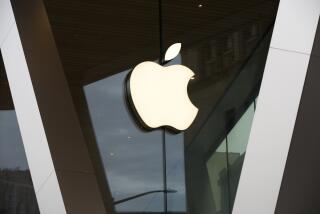Vision at Apple Finds a Partner--Management
- Share via
Apple Computer, the entrepreneurial company with the 1960-ish name, is a hot stock once again. Its price has risen more than 20% in the last month and about 90% so far this year to roughly $38 a share. What’s the reason? There are several: Earnings for the fiscal year that ends Sept. 30 will be good; also, Apple will bring out one significant computer product this fall and an even more significant one early next year.
But the biggest reason for the stock’s strength is that Wall Street is hailing the fact that entrepreneurial vision at Apple is finally coupled with solid business management.
That needs explanation. First, Apple’s earnings will probably total roughly $150 million, or $2.40 a share, for fiscal 1986, a 140% increase over last year on sales of just under $2 billion.
More importantly, this month Apple will introduce a new version of the Apple II, the most popular computer in schools and homes since 1979. And next year, Apple will introduce a new, more powerful version of its Macintosh computer, the easy-to-use little box with the extraordinary capability for graphics presentation.
New Mac Seen as Winner
Securities analysts and investors are betting that the new Mac will be a winner. They are encouraged by the success of the existing Mac, which now accounts for more than half of Apple Computer’s sales. Two years after its introduction, the Mac has come into its own. Software developers are writing programs, and the marketplace is finding uses for it, from restaurants printing menus to salespeople making presentations. The market is beginning to believe that the Macintosh, one of the only computers that is basically--or as the technical people say, architecturally--different from the IBM Personal Computer, has a bright future.
And that vindicates the vision of Steven Paul Jobs, who founded Apple Computer in 1976 with inventor Steven Wozniak in Cupertino, Calif.
Jobs led Apple to almost single-handedly create the personal computer industry, to direct the development of the Macintosh and to make a personal fortune of more than $100 million. That fortune used to be based on Apple stock but is no longer because Jobs last year sold his holdings and left the company.
Contrast With IBM PC
But that gets ahead of the story. When he founded the company, Jobs, a Central Casting entrepreneur in jeans and chamois shirt, talked of the personal computer not as a business but as a vehicle for the mind--”man can walk but goes farther and faster with a bicycle, so his thoughts can fly with a computer,” he would say.
He believed that the computer had to develop like the car--constantly becoming easier for people to learn and use. We don’t need to know much to use a car because the machine does almost all the work. We turn the key and accelerate, steer and brake.
Analogously, the Macintosh computer does a lot of the work, guiding the user via pictures on its screen and responding to instructions from a hand-held controller, dubbed a mouse. This contrasts with the IBM PC, which technical people call “command driven.” The user must give it far more instruction and know precisely how to give it--like an early shift automobile compared to today’s electronic automatics.
Great, but does that mean much in the business market, where most computers are sold? In fact it does, says technology analyst Douglas Cayne of the Gartner Group research firm. Companies find that they can train employees faster and cheaper on the Macintosh, and it is gaining acceptance. It will never replace the IBM PC, but it could be a strong alternative--especially the new version, which will be able to run IBM PC programs, thereby eliminating a current handicap for the Mac in the business market.
So Apple Computer has bright prospects immediately ahead. But progress on the human side has been tougher than on the technical side at Apple. The company is being expertly run today by Chairman John Sculley, an executive recruited to Apple in 1983 by Jobs, who realized that the company needed the discipline of business management. The visionary himself found taking direction uncomfortable, however, and quit. Sculley pulled things together and gets credit for its current success.
What then of the future? Can Apple hope to come up with products like the Macintosh that arise less from economics than from vision? Sculley, mindful of such questions, says he would welcome Jobs back. But can inventive vision and business management work together?
Well, there is a great precedent in the case of Charles F. Kettering, who led General Motors’ research for 30 years in tandem with the business management of Alfred P. Sloan. Kettering worked at his Dayton (Ohio) Engineering Laboratories (now Delco) and invented the electric starting system--a great improvement on the crank handle in ease of use. His inventiveness and Sloan’s management built GM into the world’s automotive giant.
Could Jobs and Sculley possibly create a similar productive combination at Apple? Let’s say it: With vision in business, anything is possible.






